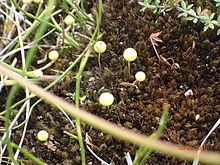| Ambuchanania | |
|---|---|

| |
| Conservation status | |
 Vulnerable (IUCN 2.3) | |
| Scientific classification | |
| Kingdom: | Plantae |
| Division: | Bryophyta |
| Class: | Sphagnopsida |
| Subclass: | Sphagnidae |
| Order: | Sphagnales |
| Family: | Ambuchananiaceae |
| Genus: | Ambuchanania Seppelt & H.A.Crum |
| Species: | A. leucobryoides |
| Binomial name | |
| Ambuchanania leucobryoides (Yamaguchi, Seppelt & Iwatsuki) Seppelt & H.A.Crum | |
| Synonyms | |
|
Sphagnum leucobryoides T.Yamag., Seppelt & Z.Iwats. | |
Ambuchanania leucobryoides is the only species in the monotypic genus Ambuchanania. It is a Sphagnum-like moss endemic to Tasmania. Originally described as a species of Sphagnum, it is now a separate genus named after the original collector Alex M. Buchanan, (b.1944) an Australian botanist from the Tasmanian Herbarium in Hobart, (it was first collected in 1987). A. leucobryoides differs from the family Sphagnaceae in having elongate antheridia. It is entirely restricted to south-west Tasmania's Wilderness World Heritage Area where it occurs on white Precambrian quartzitic sand deposited by alluvial flows, and on margins of buttongrass (Gymnoschoenus sphaerocephalus) sedge land. Species most commonly found in association with A. leucobryoides include: Leptocarpus tenax, Chordifex hookeri, and Actinotus suffocatus. Currently, A. leucobryoides is listed as rare under the Tasmanian Threatened Species Protection Act 1995.
Description

Mature plants are small, pale brown or whitish green when dry. The stems are approximately 2 cm long, and are irregularly and sparsely branched. Leaves on the stem have a broadly lanceolate shape 3.6-4.3 mm long. Spore capsules are whitish-yellow and globose, atop a seta (stalk) that is 1.2 cm long.
References
- Bryophyte Specialist Group 2000. Sphagnum leucobryoides. 2006 IUCN Red List of Threatened Species. Downloaded on 23 August 2007.
- Yamaguchi, T.; Seppelt R.D.; Iwatsuki, Z.; Buchanan, A.M. (1990). "Sphagnum (sect. Buchanania) leucobryoides sect. et sp. nov. from Tasmania" (PDF). Journal of Bryology. 16: 45–54. doi:10.1179/jbr.1990.16.1.45.
- ^ Crum, H.; Seppelt, R.D. (1999). "Sphagnum leucobryoides reconsidered". Contributions from the University of Michigan Herbarium. 22: 29–31.
- Burkhardt, Lotte (2022). Eine Enzyklopädie zu eponymischen Pflanzennamen [Encyclopedia of eponymic plant names] (pdf) (in German). Berlin: Botanic Garden and Botanical Museum, Freie Universität Berlin. doi:10.3372/epolist2022. ISBN 978-3-946292-41-8. Retrieved 27 January 2022.
- Seppelt, Rodney (2000). "The Sphagnopsida (Sphagnaceae; Ambuchaniaceae) in Australia". Hikobia.
- Johnson, K.A., Whinam, J., Buchanan, A.M. & Balmer, J. (2008) Ecological observations and new locations of a rare moss, Ambuchanania leucobryoides (Ambuchananiaceae). Papers and Proceedings of the Royal Society of Tasmania. 142 (2): 79–84.
- Shaw, A. Jonathan, 2000. Phylogeny of the Sphagnopsida Based on Chloroplast and Nuclear DNA Sequences , The Bryologist 103 (2): 277–306.
- Shaw, A. Jonathan, Cymon J. Cox & Sandra B. Boles (2003) Polarity of peatmoss (Sphagnum) evolution: who says bryophytes have no roots? , American Journal of Botany 90: 1777–1787.
| Taxon identifiers | |
|---|---|
| Ambuchanania | |
| Ambuchanania leucobryoides | |
This Australian plant article is a stub. You can help Misplaced Pages by expanding it. |
This moss-related article is a stub. You can help Misplaced Pages by expanding it. |